Terminal stations had the main problem that all trains had to get in and out at the same side of the station, reducing efficiency considerably. A much more efficient solution are through stations, which usually allow trains to enter and exit on both sides. This provides the most flexibility: Many trains will just continue their journey in the same direction, other may reverse at the station, and other may just pass through without stopping.
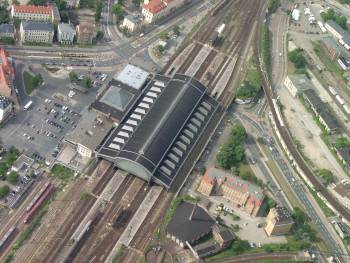
The photo shows a typical through station in a large city. Trains enter and exit the station on both ends. Of course there can be much smaller stations of the same kind, for example on branch lines with low traffic, where there might be only one platform and a branch leading to some industry. Larger stations are possible just as well, Nuremberg main station for example has 23 platforms and is the largest through station in Europe.
In the game this station setup also has advantages. Apart from the obvious topic of trains impeding each other in front of the station, extending terminal stations is rather difficult: One one side of the station there are the buildings of the city, making it next to impossible to extend the station (unless you have ways to convince the city council...). On the other side of the station there is the whole junction area that will have to be moved and maybe rebuilt completely. That may be difficult as well. With through stations, this may be easier as one can extend on both sides of the station and that will mostly affect the tracks by the player, requiring less demolition of city buildings. Additional tracks will be an issue either way.
In most situations, the question will not even arise: Terminal stations - at least for passenger traffic - only make sense at the border of the map, as that marks a definitive end of a line. With freight stations, terminals are much more prevalent, as trains usually travel back and forth between two stations, one for loading, one for unloading.
Aside from the "normal" through stations, there are also through stations for freight traffic, which is not found in the real world in that way. With that setup, trains enter the station on one side, leave on the other, and then circle around the station to go back in the direction they came from. This solves the problem of trains impeding each other in crowded terminal stations, provided you have enough room for the tracks to be laid out like that. In reality, shunting yards are used instead, but that feature is not available in the game.
Let's start with the typical through stations for passengers and mail, which can be found in countless variations in the real world.
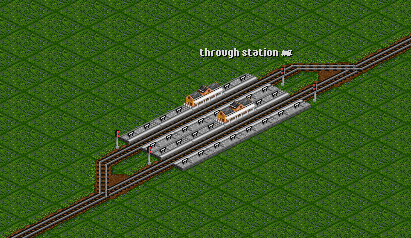
A simple through station on a single-tracked line looks roughly like this. There is a path signal on each side of the platform, facing the platform. Trains reserve paths to the platform and simply pass the signal from the backside. When leaving into the single-tracked line, they need to reserve a path. That way, no trains can block each other.
It could become a bit more complicated if there are many trains in one direction and only a few in the other direction. Then it could happen that both platforms are occupied by trains going in the same direction, meaning that a train in the opposite direction cannot reserve a path into the station. This might then be a sign that the single-tracked line may have to be upgraded.
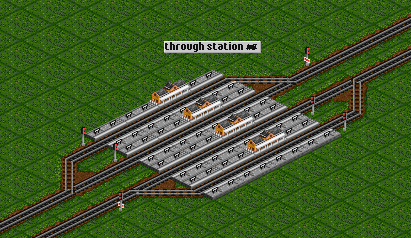
A through station at a double-tracked line can be built following the same scheme. In this example two platforms are available in each direction, the tracks for the different directions are completely separated.
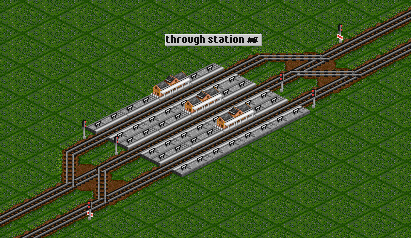
In this example, the platform in the middle can be used in both directions, the outer platforms are one-way. That provides a bit more flexibility without requiring lots of platforms. However, things become difficult when trains need to change directions at the station. In such situations, other setups are better suited (see combined stations).
The following setups show stations where all trains enter from one side, leave at the other and then circle around the station to go back to where they came from.
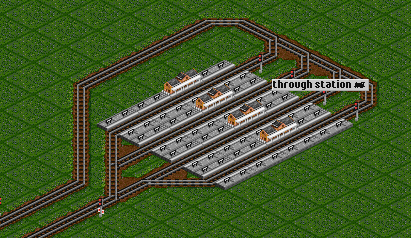
Signalling a through station is pretty straightforward. In front of the station there is a one-way path signal, which regulates entry to the platforms and prevents trains from going back that way. Trains wait at this signal when all platforms are blocked. On the exit side, standard path signals are used to regulate traffic.
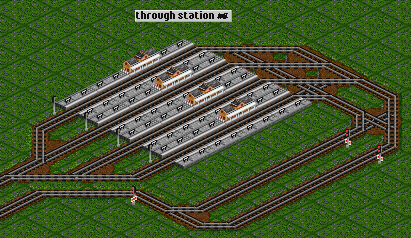
In case a station is heavily trafficked, it might be useful to build a "waiting area" in front of it, so trains can wait there for a free platform. Signalling is realized using standard path signals just like in the other examples.
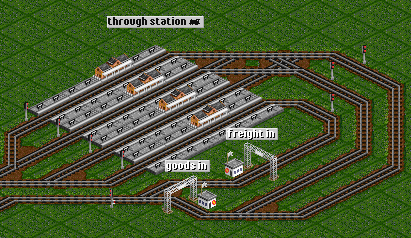
If there are trains that collect produced goods and other trains bringing raw material supplies, one should take care that the latter group always has access to a platform. Otherwise the whole station might get blocked by waiting trains, effectively shutting down production as no supplies can be delivered. One can use waypoints to ensure correct routing, trains carrying raw materials go through waypoint "freight in", the others enter through waypoint "goods in".
